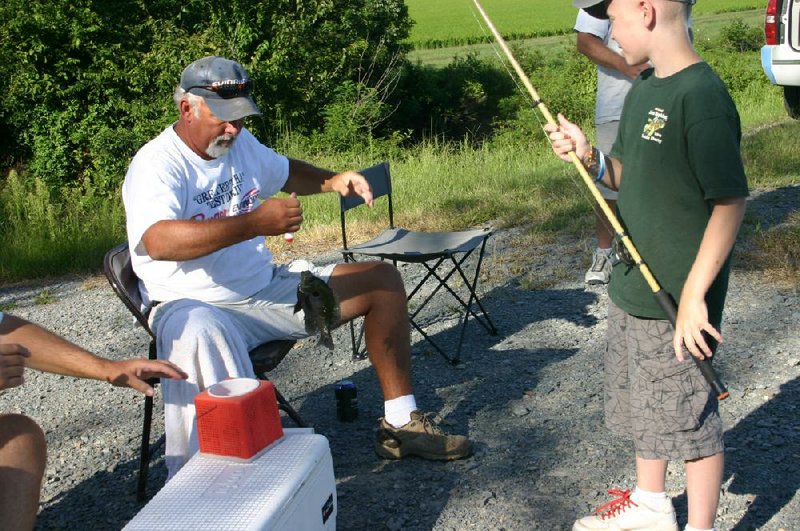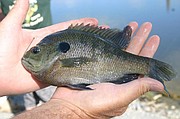Before they ever handle a rod and reel, many anglers learn to fish with a long pole and a length of fishing line.
For some, the rod is merely a long stalk of cane. The cane might be cured and lacquered, or it can be freshly cut. For others, it might be a long, manufactured rod of fiberglass or graphite. It also can be a long crappie rod with a small reel to hold line in a neat, orderly fashion.
For me, as a beginning angler in the early 1970s, it was one of my father's discarded rods with a broken tip. I sawed off the broken tip down to the next guide. I cut a 10-foot length of monofilament line from one of his Johnson Century closed face spincasting reels. I tied one end to the rod tip and wrapped the rest around the rod, unwinding only as much as I needed for whatever water I fished.
In the beginning, they were the three golf course ponds near my home. They were loaded with bream. That's also where I saw my first largemouth bass, caught on a casting spoon by a girl named Kelly Willis, a classmate at McDermott Elementary School in 1970-71. In 1972, when my family moved to Sherwood, I used this same rig for years to fish the creeks near our neighborhood.
[Video not showing up above? Click here to watch » https://www.youtube.com/watch?v=b3T6bB0jA9Y]
Regardless of the implement, the concept is the same, and it is a remarkably productive and efficient way to fish. It is essentially Tenkara, a method of fly fishing that originated in Japan. As defined at tenkarausa.com, Tenkara uses only a rod, line and fly.
"It shines in mountain streams, where the long rod and light line provide the best possible fly presentation," the website says. "Tenkara is also effective in a variety of waters, such as alpine lakes, or urban ponds for panfish and bass."
There! Tenkara is both a novice and advanced fishing method, an Alpha and Omega, a beginning and the end. Let's get started, shall we?
With your line wound around the end of your cane pole, simply unwrap an appropriate amount for the lake, pond or stream you are fishing. On the terminal end is a hook or a light jig, of course, with a heavy enough split shot to sink the bait you are using. Depending on the bait, additional weight might not be necessary.
To "cast," grip the bait between two fingers and leverage the rod tip to swing the bait to the desired location. It's as easy as that.
In the beginning, you might be more comfortable using a bobber to regulate the bait depth, which should be a few inches off the bottom. On the other hand, a clip-on bobber is cumbersome to cast and control. A slip cork is more manageable, but it requires attaching a bobber stopper to the line to stop the bobber at a preset depth.
As you get proficient, you can omit the bobber and fish with a tight line. Instead of watching for a bobber to plunge, you will feel the strike. This will help you develop and refine a sense of feel. A finely-honed sense of touch is the most vital element in your evolution as an angler, culminating in the mastery of fly fishing and, perhaps eventually, the mastery of Tenkara.
This is a versatile fishing method from the bank, from a boat or by wade fishing. Fishing from the bank with a cane pole is a distinctively southern image, and it is a great way to catch bream, catfish and occasionally bass. It is especially productive in late March and early April when bluegills are spawning within a line flip from the banks. That's also when catfish cruise the bank looking to vacuum up bream eggs and bream fry.
A boat enables you to fish the banks without interference from limbs and brush. It also enables you to fish offshore cover like shallow brushpiles and the outside edges of grassbeds, and from the outboard, deeper sides of bankside logs and other submerged cover.
As a child, I spent many happy weekends with my dad on his houseboat at the old Medlin's Marina at Lake Hamilton. I fished all of the docks around the marina all the way to Peter's Point. Bream concentrated under the docks, and I fished from morning to night.
Right now, pole fishing is ideal for catching spawning crappie by daubing small jigs or live minnows next to cypress trees. You can do this by boat or by wading if the water is shallow enough.
Sculling a flatbottom boat, you can ease from one piece of cover to another. The long pole keeps you away from the cover and avoids spooking fish. You can also do this with a fishing kayak, but the small deck space and a long kayak paddle can make pole fishing challenging. It is easier with a pedal-powered kayak, especially if you have an anchor pole or an anchor trolley to prevent you from drifting too close to the cover.
Wade fishing with a long pole was the genesis of my love for stream fishing. I would spend all of my time with friends fishing Woodruff Creek in Sherwood from Club Road all the way to North Hills Boulevard. We caught mostly longear sunfish, along with bluegills and occasionally even crappie in the deep holes near Club Road. Before Henson Park was built, that section of the creek was undeveloped and contained a couple of deep holes that held chain pickerel. Hanging over the vertical bank with my foot wedged on a tree root, I tried like heck to catch a chain pickerel, but I never got one to bite.
Those idyllic days with a derelict fishing rod spawned a lifelong love for fishing that ultimately became a career. It's powerful stuff, and it's easy to learn and to do.
This is the first in a series about learning the art of fishing.
Sports on 04/02/2020


